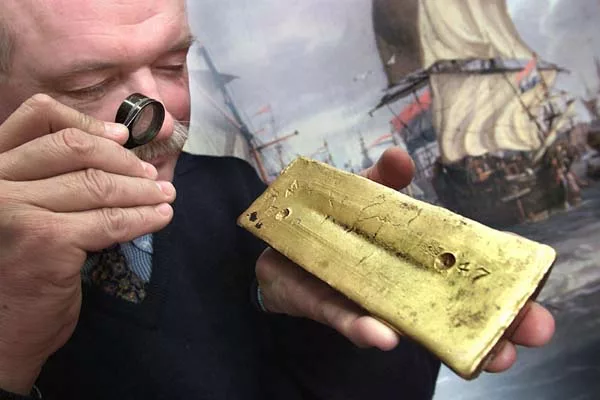Home > Shipwreck Blogs > The only remaining VOC-made gold bar was stolen and never found
On March 28, 2000, the Dutch Royal Coin Cabinet (Koninklijk Penningkabinet) in Leiden received a unique gold bar on loan from the Ministry of Finance, which had purchased it shortly before from Gavin Glackworthy. He was a South African diver who worked with permission from the local government on wrecks around Cape Verde. After years of research and searching, Glackworthy discovered the wreck site of the Leimuiden, which ran aground at the island of Boa Vista on January 25, 1770. It was at this site where he uncovered the only remaining VOC-made gold bar in existence—an 18-karat bar measuring 20 × 6 × 3 cm and weighing 4.92 kg.
The Leimuiden, also spelled Leymuiden, was a Dutch east Indiaman that made voyages between Texel, Batavia, Dejima and Ceylon from 1755 up until the moment it sank. On her fatal journey in 1769 she left Texel for Ceylon with a cargo that included among others 37 gold bars that were exclusively made for the VOC in the city of Amsterdam. Shipping gold bars of standard weight and purity only started in the second half of the 18th century. Previously, starting from 1680, gold bars had been transported in various sizes, weights, and purities—sometimes even coins were sent under this designation. However, their origin is unknown, and they may well have been (at least partly) of Spanish-American origin. Like the silver bars that the VOC shipped on a significantly bigger scale, the gold bars were also made with the purpose to be remelted upon arrival in the East Indies into local currencies. Hence, that no VOC-made gold bars remain in existence, besides the one that was recovered from the Leimuiden shipwreck.

@wrecktreasure Th bizarre story of the sunken VOC ship the Leimuiden! #shipwrecktreasure #shipwreck #voc #dutcheastindiacompany #treasure #mutiny #leimuidenshipwreck #fyp #history ♬ origineel geluid - wrecktreasure
The loss of the Leimuiden was marked not only by the destruction of the ship and its cargo but also by the controversial actions of its captain, Jan van Kinsbergen. Instead of ensuring the safety of his crew, he prioritized his own escape, selecting only a handful of men to accompany him while leaving the majority behind. Those abandoned on the sinking vessel had no choice but to construct makeshift rafts in a desperate attempt to reach the shore. Tragically, around fifteen men never made it, including the sailor Abraham Kats, who had taken nine gold bars with him, weighing a total of 45 kilograms. The burden proved too great, and he drowned before reaching land.
Survivors who managed to reach the shore were soon confronted with further hardship when Van Kinsbergen demanded the return of the salvaged gold bars. Despite the original cargo consisting of 37 bars, only 16 were recovered. The fate of the remaining gold remains a mystery—whether lost at sea, secretly taken by survivors, or looted in the aftermath of the wreck. When the site was rediscovered centuries later, only one gold bar was found. The surviving crew members were eventually rescued by the passing ship Renswoude, which transported them to the Cape of Good Hope before continuing its journey to Ceylon, carrying what was left of the Leimuiden’s salvaged cargo.
The Dutch Royal Coin Cabinet proudly made this unique gold bar a centerpiece of their collection. However, on the afternoon of Wednesday, April 19, less than a month after its arrival at the museum in Leiden, it was stolen. The thief shattered the glass of the secured display case, seized the gold bar, and fled. Four security guards responded immediately, but when they attempted to stop him, he sprayed them in the face with pepper spray and managed to escape in a car. About half an hour later, the abandoned vehicle was discovered near the museum and was found to have been stolen. To this day, the whereabouts of the gold bar remain unknown, but it is widely believed that it was melted down and sold for its gold content, erasing a rare artifact of VOC history.
Unfortunately, detailed photographs of the gold bar are unavailable, likely because it was only on public display for a very short time. After consulting the Dutch Numismatic Collection, we were informed that they do not have any digital images of the bar. It is possible that one or more analog photographs exist in the archives of the Dutch Royal Coin Cabinet, but this remains uncertain. Once the archive becomes accessible again following its relocation in June 2025, we will review its contents and add any relevant images if they are found.
Did you enjoy this blog? Be sure to check out our TikTok for more stories like this, or visit our shop to own a piece of maritime history yourself!